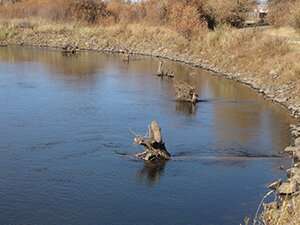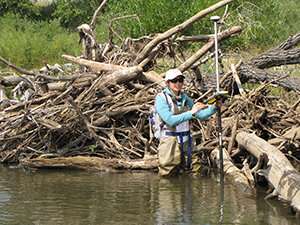Trout habitat improvements also benefit nongame native fish

Habitat improvements in the Laramie River intended to boost the brown trout fishery also have benefited native nongame fish, according to newly published research by University of Wyoming scientists.
That finding is good news for anglers, the introduced brown trout they pursue and native nongame species in Great Plains rivers, such as the Laramie River, say UW Department of Zoology and Physiology Professor Frank Rahel and his former graduate student, Jessica Dugan. She is now a fisheries biologist with the Wyoming Game and Fish Department in Casper.
"It is important to identify restoration actions that benefit native fishes even in the presence of nonnative fishes," the scientists wrote in a paper published in the North American Journal of Fisheries Management. "Our research shows it is possible for native small-bodied fishes to coexist with a large-bodied game species under the right conditions."
The Laramie River, like many Great Plains rivers, did not have trout before settlement by Europeans in the 19th century. Brown trout, which are native to Europe, were introduced and are a popular game species for anglers. But the Laramie River also has nine species of native fish, including the creek chub, common shiner, longnose sucker and white sucker.

In some bodies of water, the introduction of brown trout, which prey on other fish, has harmed the populations of small, native fish species.
In the Laramie River, a number of habitat improvements have been undertaken to boost the brown trout fishery, including placement of trees and logs to create additional structure, and rock riprap to prevent channel meandering. At four locations in the river near Laramie—including the public Monolith Ranch and Laramie Greenbelt sites—Rahel and Dugan studied the impact of habitat improvements on both brown trout and the smaller native fish.
They found that both brown trout and all but one species of the smaller native fish are drawn to the additional structure created by habitat improvements—especially wood placed in the river. Both added wood and natural wood patches—exposed roots, submerged branches and log jams—provide spaces for the smaller fish to hide from the brown trout, which also favor the additional structure.
The researchers suggest their findings could help guide future habitat improvements not only in the Laramie River, but also other Great Plains rivers with limited natural structural habitat. In general, the more complex the wood structure, the better habitat it provides for small, native fish species.
"It is encouraging that small-bodied native fish will use added cover types intended to benefit brown trout," Rahel and Dugan say. "Providing a sport fishery while maintaining populations of native nongame fish is an ongoing challenge for fisheries managers."
More information: Jessica A. Dugan et al. Use of Natural and Added Cover Types by Game and Nongame Fishes in a Great Plains River, North American Journal of Fisheries Management (2019). DOI: 10.1002/nafm.10332
Provided by University of Wyoming
















